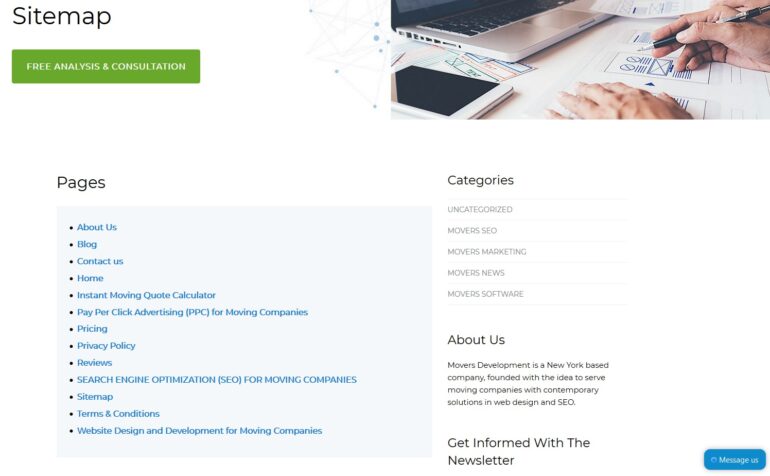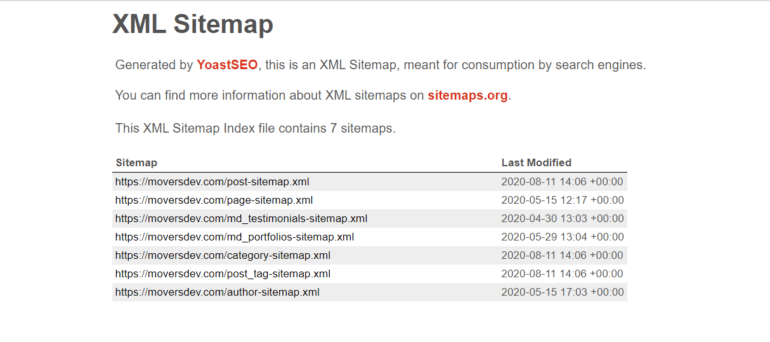Every journey needs a map, and navigating a website is no different. After all, sitemaps provide a visual representation of your website’s structure, which can drastically improve your visitors’ experience. The same is true for spiders and crawlers; complex websites present a harder challenge for them, which sitemaps help alleviate. They are thus a noteworthy asset, especially for websites dedicated to the moving industry. From improving your visitors’ experience to enhancing SEO efforts, sitemaps can indeed offer much to your moving company website. In this article, we will explore the main reasons why your website needs a sitemap, and how they function.
The fundamental types of sitemaps
Before delving into the exact nature and function of sitemaps, it is vital to make a distinction among sitemap types. The term is rather broad, and it, therefore, encompasses distinctly different meanings.
The term most often includes 2 main sitemap types; HTML and XML. The two serve unique functions, so one should consider them individually. The former is readily visible to human visitors and, in the majority of cases, mostly aid in navigation. In contrast, the latter is hidden and intend to let search engines crawl the page more efficiently. In essence, HTML sitemaps enhance the UX of your site visitors, while XML sitemaps are reserved for spiders and crawlers.

Naturally, since both are significant, both are valid reasons why your website needs a sitemap to perform better. That is, in part, why major CMS platforms like WordPress endorse and facilitate sitemaps. Admittedly, they do overlap with software for small moving companies, like CRM solutions, in terms of enhancing functionality and customer interaction.
What is an HTML sitemap?
As outlined above, HTML sitemaps are an additional navigation tool for visitors. Organized page structure and menus can suffice for smaller websites in this regard, but as websites expand sitemaps become essential. They can allow visitors to access specific pages, ensuring “main”, high-value pages are not orphaned or hard to find. Lastly, they also offer some SEO benefits, They are thus more useful to large websites with large amounts of content, as they provide better organization and accessibility.

HTML sitemaps are, fortunately, quite easy to create. Some platforms don’t create them automatically, but some major CMS platforms such as WordPress do offer sitemap plugins that do.
Why does your website need an HTML sitemap?
In essence, HTML sitemaps offer two main benefits; an enhanced user experience, and improved SEO.
An enhanced user experience
Most notably, such sitemaps improve your site’s content’s accessibility and visibility, improving your visitors’ navigation. They do so in the following ways.
1. Better organization
As websites expand, so too does the amount of their content. This process may result in a diminishing organization, where your visitors won’t readily know what your site offers. A pristine sitemap can help alleviate this, by organizing valuable pages and ensuring your visitors need few, specific steps to convert.
2. A better definition of a website’s purpose
Among the most notable reasons why your website needs a sitemap is the definition of its purpose. Visitors may leave a website without converting if they struggle to understand a site’s exact purpose and offers. An organized sitemap serves as a clear statement of your website’s purpose, and thus its value.
Improved SEO
While enhanced user navigation is arguably their main function, HTML sitemaps can indeed offer some SEO benefits as well. They do so in the following ways.
1. Content optimization
Sitemap reports can provide invaluable information on visitor behavior. Through it, you can better understand which content and which keywords generate more traffic and optimize your content accordingly.
2. Search engine visibility optimization
An organized sitemap can likewise assist spiders and crawlers as they index every webpage on your site. In 2016, Google’s analyst John Mueller discussed how HTML sitemaps do “sometimes” have SEO value for more structurally complex sites. However, it is noteworthy that XML sitemaps serve this function more effectively, as we will discuss shortly.
What is an XML sitemap
Unlike HTML sitemaps, XML sitemaps are strictly reserved for search engines and their bots. In essence, they contain a list of all the URLs a website contains, as well as relevant metadata such as the following:
- Last update time of each page
- Update frequency for each page
- Importance and value of each page compared to others
Thus, such sitemaps do not intend to assist your human visitors. Instead, they are designed to be submitted to search engines for indexing purposes. They are particularly useful for larger sites as well and are thus a vital tool when delving into SEO development for movers.

XML sitemaps do require some coding knowledge to create. However, external tools and services, as well as such WordPress plugins as Yoast SEO can do so for you.
Why your website needs an XML sitemap
By definition, XML sitemaps the distinct benefit of improved search engine visibility, and thus SEO.
Improved SEO
Underperforming SEO may be a good indication that your website needs a sitemap. Search crawlers may, at times, delay indexing your content pages or do so in an incomplete fashion. Such factors as imperfect internal linking can reduce your website’s search engine visibility as well. XML sitemaps address both of these concerns, by providing crawlers with a complete, thorough list of the entirety of your content. Therefore, they can index your website more quickly and more efficiently, especially given the metadata that XML sitemaps can contain.
1. Crawling prioritization
XML sitemaps’ metadata includes the priority attribute. Therefore, you can set a higher crawling priority value for your main, valuable pages, and a lower priority for secondary pages. In doing so, you can ensure that indexing delays and omissions don’t hamper your SEO efforts.
2. Improved multimedia content ranking
As outlined above, XML sitemaps can contain invaluable metadata. You can use this feature to add metadata on your multimedia content, such as images and videos, including the following:
- Location
- Description
- View count and rating
Such information can, in turn, allow search engines to rank such content higher, enhancing your SEO score.
Your site needs a sitemap
It should thus be clear that there are many benefits to using a sitemap of either type – or both. Moving websites tend to expand over time, and enhanced user experience and SEO are both valuable goals to pursue. Sitemaps are rather easy to create, contrary to popular belief and can incur no penalties. On the contrary, they offer distinct advantages that can help your website grow and prosper.






